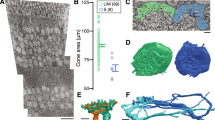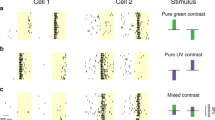Abstract
The mammalian retina is fundamentally dichromatic, with trichromacy only recently emerging in some primates. In dichromats, an array of short wavelength–sensitive (S, blue) and middle wavelength–sensitive (M, green) cones is sampled by approximately ten bipolar cell types, and the sampling pattern determines how retinal ganglion cells and ultimately higher visual centers encode color and luminance. By recording from cone–bipolar cell pairs in the retina of the ground squirrel, we show that the bipolar cell types sample cone signals in three ways: one type receives input exclusively from S-cones, two types receive mixed S/M-cone input and the remaining types receive an almost pure M-cone signal. Bipolar cells that carry S- or M-cone signals can have a role in color discrimination and may contact color-opponent ganglion cells. Bipolar cells that sum signals from S- and M-cones may signal to ganglion cells that encode luminance.
This is a preview of subscription content, access via your institution
Access options
Subscribe to this journal
Receive 12 print issues and online access
$209.00 per year
only $17.42 per issue
Buy this article
- Purchase on Springer Link
- Instant access to full article PDF
Prices may be subject to local taxes which are calculated during checkout








Similar content being viewed by others
References
Curcio, C.A. et al. Distribution and morphology of human cone photoreceptors stained with anti-blue opsin. J. Comp. Neurol. 312, 610–624 (1991).
Kryger, Z., Galli-Resta, L., Jacobs, G.H. & Reese, B.E. The topography of rod and cone photoreceptors in the retina of the ground squirrel. Vis. Neurosci. 15, 685–691 (1998).
Calkins, D.J. Seeing with S cones. Prog. Retin. Eye Res. 20, 255–287 (2001).
Li, W. & DeVries, S.H. Separate blue and green cone networks in the mammalian retina. Nat. Neurosci. 7, 751–756 (2004).
Mariani, A.P. Bipolar cells in monkey retina selective for the cones likely to be blue-sensitive. Nature 308, 184–186 (1984).
Kouyama, N. & Marshak, D.W. Bipolar cells specific for blue cones in the macaque retina. J. Neurosci. 12, 1233–1252 (1992).
Calkins, D.J., Tsukamoto, Y. & Sterling, P. Microcircuitry and mosaic of a blue-yellow ganglion cell in the primate retina. J. Neurosci. 18, 3373–3385 (1998).
Haverkamp, S. et al. The primordial, blue-cone color system of the mouse retina. J. Neurosci. 25, 5438–5445 (2005).
Dacey, D.M. & Lee, B.B. The 'blue-ON' opponent pathway in primate retina originates from a distinct bistratified ganglion cell type. Nature 367, 731–735 (1994).
Boycott, B.B. & Wässle, H. Morphological classification of bipolar cells of the primate retina. Eur. J. Neurosci. 3, 1069–1088 (1991).
Chan, T.L., Martin, P.R., Clunas, N. & Grünert, U. Bipolar cell diversity in the primate retina: morphologic and immunocytochemical analysis of a new world monkey, the marmoset Callithrix jacchus. J. Comp. Neurol. 437, 219–239 (2001).
Lee, S.C., Jusuf, P.R. & Grünert, U. S-cone connections of the diffuse bipolar cell type DB6 in macaque monkey retina. J. Comp. Neurol. 474, 353–363 (2004).
Herr, S., Klug, K., Sterling, P. & Schein, S. Inner S-cone bipolar cells provide all of the central elements for S cones in macaque retina. J. Comp. Neurol. 457, 185–201 (2003).
Calkins, D.J., Tsukamoto, Y. & Sterling, P. Foveal cones form basal as well as invaginating junctions with diffuse ON bipolar cells. Vision Res. 36, 3373–3381 (1996).
Calkins, D.J. Synaptic organization of cone pathways in the primate retina. in Color Vision: from Genes to Perception (eds. Gegenfurtner, K.R. & Sharpe, L.T.) Ch. 8, 163–179 (Cambridge University Press, Cambridge, UK, 1999).
Haverkamp, S., Grünert, U. & Wässle, H. Localization of kainate receptors at the cone pedicles of the primate retina. J. Comp. Neurol. 436, 471–486 (2001).
Dacey, D.M. & Lee, B.B. Functional architecture of cone signal pathways in the primate retina. in Color Vision: from Gene to Perception (eds. Gegenfurtner, K.R. & Sharpe, L.T.) Ch. 9, 181–202 (Cambridge University Press, Cambridge, UK, 1999).
Sun, H., Smithson, H.E., Zaidi, Q. & Lee, B.B. Specificity of cone inputs to macaque retinal ganglion cells. J. Neurophysiol. 95, 837–849 (2006).
Chatterjee, S. & Callaway, E.M. S cone contributions to the magnocellular visual pathway in macaque monkey. Neuron 35, 1135–1146 (2002).
Reid, R.C. & Shapley, R.M. Space and time maps of cone photoreceptor signals in macaque lateral geniculate nucleus. J. Neurosci. 22, 6158–6175 (2002).
Seidemann, E., Poirson, A.B., Wandell, B.A. & Newsome, W.T. Color signals in area MT of the macaque monkey. Neuron 24, 911–917 (1999).
Wandell, B.A. et al. Color signals in human motion-selective cortex. Neuron 24, 901–909 (1999).
Dacey, D.M., Peterson, B.B., Robinson, F.R. & Gamlin, P.D. Fireworks in the primate retina: in vitro photodynamics reveals diverse LGN-projecting ganglion cell types. Neuron 37, 15–27 (2003).
Jacobs, G.H. & Tootell, R.B. Spectral-response properties of optic-nerve fibers in the ground squirrel. J. Neurophysiol. 45, 891–902 (1981).
Martin, P.R. Colour processing in the primate retina: recent progress. J. Physiol. (Lond.) 513, 631–638 (1998).
Klug, K., Herr, S., Ngo, I.T., Sterling, P. & Schein, S. Macaque retina contains an S-cone OFF midget pathway. J. Neurosci. 23, 9881–9887 (2003).
Schnapf, J.L., Nunn, B.J., Meister, M. & Baylor, D.A. Visual transduction in cones of the monkey Macaca fascicularis. J. Physiol. (Lond.) 427, 681–713 (1990).
Kraft, T.W. Photocurrents of cone photoreceptors of the golden-mantled ground squirrel. J. Physiol. (Lond.) 404, 199–213 (1988).
DeVries, S.H. & Schwartz, E.A. Kainate receptors mediate synaptic transmission between cones and 'Off' bipolar cells in a mammalian retina. Nature 397, 157–160 (1999).
DeVries, S.H. Exocytosed protons feedback to suppress the Ca2+ current in mammalian cone photoreceptors. Neuron 32, 1107–1117 (2001).
Yagi, T. & Macleish, P.R. Ionic conductances of monkey solitary cone inner segments. J. Neurophysiol. 71, 656–665 (1994).
Vardi, N., Duvoisin, R., Wu, G. & Sterling, P. Localization of mGluR6 to dendrites of ON bipolar cells in primate retina. J. Comp. Neurol. 423, 402–412 (2000).
Snellman, J. & Nawy, S. cGMP-dependent kinase regulates response sensitivity of the mouse ON bipolar cell. J. Neurosci. 24, 6621–6628 (2004).
DeVries, S.H. Bipolar cells use kainate and AMPA receptors to filter visual information into separate channels. Neuron 28, 847–856 (2000).
Cuenca, N. et al. The neurons of the ground squirrel retina as revealed by immunostains for calcium binding proteins and neurotransmitters. J. Neurocytol. 31, 649–666 (2002).
DeVries, S.H., Qi, X., Smith, R., Makous, W. & Sterling, P. Electrical coupling between mammalian cones. Curr. Biol. 12, 1900–1907 (2002).
West, R.W. Light and electron microscopy of the ground squirrel retina: functional considerations. J. Comp. Neurol. 168, 355–377 (1976).
Linberg, K.A., Suemune, S. & Fisher, S.K. Retinal neurons of the California ground squirrel, Spermophilus beecheyi: a Golgi study. J. Comp. Neurol. 365, 173–216 (1996).
Caldwell, J.H. & Daw, N.W. New properties of rabbit retinal ganglion cells. J. Physiol. (Lond.) 276, 257–276 (1978).
Hochstein, S. & Shapley, R.M. Quantitative analysis of retinal ganglion cell classifications. J. Physiol. (Lond.) 262, 237–264 (1976).
Zhang, J., Li, W., Hoshi, H., Mills, S.L. & Massey, S.C. Stratification of alpha ganglion cells and ON/OFF directionally selective ganglion cells in the rabbit retina. Vis. Neurosci. 22, 535–549 (2005).
Dacey, D.M. & Brace, S. A coupled network for parasol but not midget ganglion cells in the primate retina. Vis. Neurosci. 9, 279–290 (1992).
Chichilnisky, E.J. & Kalmar, R.S. Functional asymmetries in ON and OFF ganglion cells of primate retina. J. Neurosci. 22, 2737–2747 (2002).
Jacoby, R.A., Wiechmann, A.F., Amara, S.G., Leighton, B.H. & Marshak, D.W. Diffuse bipolar cells provide input to OFF parasol ganglion cells in the macaque retina. J. Comp. Neurol. 416, 6–18 (2000).
Yamada, E.S., Bordt, A.S. & Marshak, D.W. Wide-field ganglion cells in macaque retinas. Vis. Neurosci. 22, 383–393 (2005).
Jacobs, G.H. Comparetive psychology of vision. in Handbook of Psychology Vol. 3 (eds. Gallagher, M. & Nelson, R.J.) Ch. 3, 47–70 (Wiley, New York, 2002).
Jacobs, G.H., Blakeslee, B. & Tootell, R.B. Color-discrimination tests on fibers in ground squirrel optic nerve. J. Neurophysiol. 45, 903–914 (1981).
Chichilnisky, E.J. & Baylor, D.A. Receptive-field microstructure of blue-yellow ganglion cells in primate retina. Nat. Neurosci. 2, 889–893 (1999).
Dacey, D.M. et al. Melanopsin-expressing ganglion cells in primate retina signal colour and irradiance and project to the LGN. Nature 433, 749–754 (2005).
Lee, S.C., Telkes, I. & Grünert, U. S-cones do not contribute to the OFF-midget pathway in the retina of the marmoset, Callithrix jacchus. Eur. J. Neurosci. 22, 437–447 (2005).
Acknowledgements
The authors wish to thank S. Massey, J. Singer, S. Saszik and A. Light for critical reading of the manuscript. This work was supported by US National Institutes of Health grant (EY12141), a Research to Prevent Blindness grant to S.H.D. and a Fight For Sight Fellowship to W.L.
Author information
Authors and Affiliations
Corresponding author
Ethics declarations
Competing interests
The authors declare no competing financial interests.
Supplementary information
Supplementary Fig. 1
Morphological consistency of identified bipolar cell types. (PDF 403 kb)
Supplementary Fig. 2
Diagram of S- and M-cone inputs to different bipolar cell pathways. (PDF 1170 kb)
Rights and permissions
About this article
Cite this article
Li, W., DeVries, S. Bipolar cell pathways for color and luminance vision in a dichromatic mammalian retina. Nat Neurosci 9, 669–675 (2006). https://doi.org/10.1038/nn1686
Received:
Accepted:
Published:
Issue Date:
DOI: https://doi.org/10.1038/nn1686
This article is cited by
-
Transmission at rod and cone ribbon synapses in the retina
Pflügers Archiv - European Journal of Physiology (2021)
-
The temporal structure of the inner retina at a single glance
Scientific Reports (2020)
-
Characterization of connexin36 gap junctions in the human outer retina
Brain Structure and Function (2016)
-
Retinal bipolar cells: elementary building blocks of vision
Nature Reviews Neuroscience (2014)
-
Opsin Genes and Visual Ecology in a Nocturnal Folivorous Lemur
International Journal of Primatology (2014)



